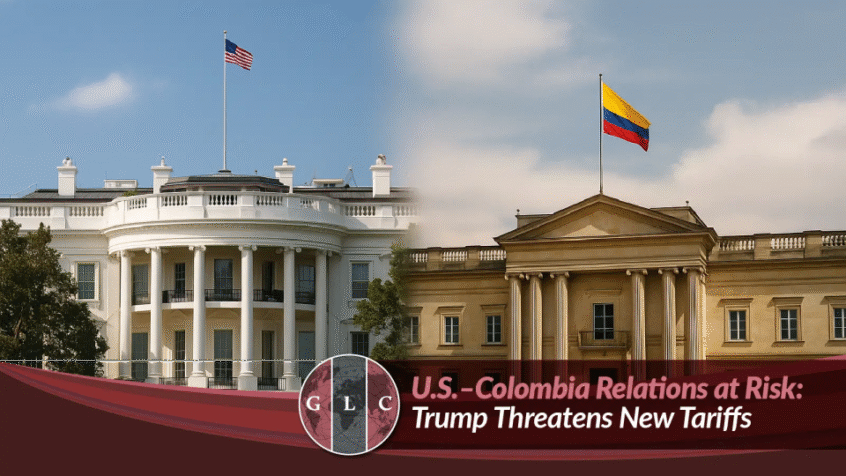In a sudden escalation that rippled through global trade headlines, President Donald Trump announced that the U.S. would end aid to Colombia and impose new tariffs on Colombian exports. The announcement followed public accusations that Colombian President Gustavo Petro had failed to curb drug production, a claim Petro strongly rejected as “an attack on national sovereignty.”
What might appear to be a diplomatic dispute is quickly becoming a supply chain event with real implications for importers, exporters, and logistics networks across the Americas.
A Breakdown of the Situation
For decades, Colombia has been one of the United States’ most strategic partners in Latin America, a cornerstone for trade, counter-narcotics cooperation, and regional stability. The proposed end to U.S. assistance and introduction of tariffs marks a significant departure from historical collaboration.
According to reports:
- The U.S. announced plans to suspend economic aid to Colombia.
- Tariffs are expected to target a range of agricultural and manufactured goods.
- The Colombian peso dropped sharply as markets reacted to the news.
- A senior White House economic adviser, Kevin Hassett, later said there is no announcement planned to raise tariffs on Colombia at this time, leaving the threat uncertain
The Supply Chain Impact
1. Trade Disruption and Sourcing Risk
Tariffs translate directly into higher landed costs for importers. From coffee and textiles to raw materials and components, the U.S.–Colombia supply lane supports thousands of small and medium-sized enterprises. As tariffs rise, those businesses face difficult choices: absorb the cost, shift suppliers, or pass it on to consumers.
For supply chain leaders, this is a reminder that geopolitical risk is now a core business variable. Even historically stable partners can become high-risk overnight.
2. Logistics and Infrastructure Delays
Diplomatic tension often cascades into practical disruptions: increased customs scrutiny, longer inspection times, and potential slowdowns at ports and airports. If cooperation between U.S. and Colombian trade agencies cools, delays at border crossings and ports could become routine.
3. Currency and Inflation Exposure
The Colombian peso’s immediate depreciation, roughly 1.4% after the announcement, signals that broader macroeconomic volatility could follow. For logistics operators and multinational clients, this volatility affects contract pricing, freight settlements, and profitability.
4. Regional Realignments
The standoff may push Colombia to strengthen trade links with China, the European Union, or regional blocs like Mercosur. Such shifts would rewire cargo routes, alter air and ocean freight demand, and possibly divert flows from U.S. ports to others in Latin America or Asia.
What Supply Chain Leaders Should Do Now
1. Assess Exposure:
Identify suppliers, customers, and logistics partners that depend on U.S.–Colombia trade lanes. Quantify potential tariff impact on landed cost.
2. Build Scenarios:
Simulate multiple outcomes, tariffs at 5%, 10%, 15%, to understand at what point margins erode. Model potential shifts in shipping times and costs.
3. Diversify Logistics Corridors:
Explore alternate sourcing or routing via Mexico, Panama, or Ecuador. Diversification ensures agility if customs friction increases.
4. Strengthen Supplier Communication:
Stay proactive. Engage directly with Colombian suppliers to understand how they’re preparing for changes and whether alternate fulfillment plans exist.
5. Monitor Trade Announcements Closely:
Trade policies are fluid. Regularly check updates from USTR, CBP, and Colombia’s Ministry of Commerce to stay ahead of tariff rollouts or exemptions.
Industry-Specific Implications
E-Commerce & Retail: Higher import duties could drive up consumer prices, especially for niche goods sourced from Colombia.
Pharmaceuticals: Any disruption to temperature-controlled shipments or customs clearance could jeopardize sensitive medical cargo.
Automotive & CPG: Manufacturers sourcing raw materials or packaging from Colombia may face added complexity in procurement planning.
For logistics leaders, the winners will be those who integrate geopolitical foresight into daily operations, not as an afterthought but as a competitive advantage.
With offices strategically located in both the United States and Colombia, Global Logistical Connections is uniquely positioned to support your business through moments of trade uncertainty. If you have any questions about your imports or exports to and from Colombia, don’t hesitate to contact our team at [email protected], or request a quote . We’re here to help you navigate changes with clarity, compliance, and confidence.

